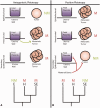Malignant cancer and invasive placentation: A case for positive pleiotropy between endometrial and malignancy phenotypes
- PMID: 25324490
- PMCID: PMC4217742
- DOI: 10.1093/emph/eou022
Malignant cancer and invasive placentation: A case for positive pleiotropy between endometrial and malignancy phenotypes
Abstract
Cancer metastasis is an invasive process that involves the transplantation of cells into new environments. Since human placentation is also invasive, hypotheses about a relationship between invasive placentation in eutherian mammals and metastasis have been proposed. The relationship between metastatic cancer and invasive placentation is usually presented in terms of antagonistic pleiotropy. According to this hypothesis, evolution of invasive placentation also established the mechanisms for cancer metastasis. Here, in contrast, we argue that the secondary evolution of less invasive placentation in some mammalian lineages may have resulted in positive pleiotropic effects on cancer survival by lowering malignancy rates. These positive pleiotropic effects would manifest themselves as resistance to cancer cell invasion. To provide a preliminary test of this proposal, we re-analyze data from Priester and Mantel (Occurrence of tumors in domestic animals. Data from 12 United States and Canadian colleges of veterinary medicine. J Natl Cancer Inst 1971; 47: :1333-44) about malignancy rates in cows, horses, cats and dogs. From our analysis we found that equines and bovines, animals with less invasive placentation, have lower rates of metastatic cancer than felines and canines in skin and glandular epithelial cancers as well as connective tissue sarcomas. We conclude that a link between type of placentation and species-specific malignancy rates is more likely related to derived mechanisms that suppress invasion rather than different degrees of fetal placental aggressiveness.
Keywords: antagonistic pleiotropy; cancer; evolution of malignancy; evolution of placentation.
© The Author(s) 2014. Published by Oxford University Press on behalf of the Foundation for Evolution, Medicine, and Public Health.
Figures


References
-
- Buss LW. The Evolution of Individuality. New York: Columbia University Press; 1987.
-
- Simpson AJ, Camargo AA. Evolution and the inevitability of human cancer. Semin Cancer Biol. 1998;8:439–45. - PubMed
-
- Nowell PC. The clonal evolution of tumor cell populations. Science. 1976;194:23–8. - PubMed
-
- Murray MJ, Lessey BA. Embryo implantation and tumor metastasis: common pathways of invasion and angiogenesis. Semin Reprod Endocrinol. 1999;17:275–90. - PubMed
Publication types
LinkOut - more resources
Full Text Sources
Other Literature Sources
Miscellaneous

